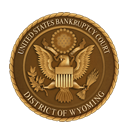ELECTRONIC EVIDENCE PRESENTATION SYSTEM
The United States Bankruptcy Court for the District of Wyoming installed an electronic evidence presentation system in the courtroom. The evidence presentation system allows the display of evidence on various monitors located on the bench, witness stand, lectern and counsels’ tables. Additional new equipment includes a courtroom-wide speaker system, a screen near the gallery, cameras for video-conferencing purposes and assisted listening headsets.
Having installed the electronic evidence system, the court encourages counsel to learn its ease of use. The court also implemented procedures for the electronic filing of proposed exhibits. Neither use or filing is a mandate, but parties shall follow current procedures set forth as frequently asked questions.
FREQUENTLY ASKED QUESTIONS:
- What kind of content may be displayed using the evidence presentation system? Documents, images/pictures, video playback and audio playback.
- What types of devices may be used for evidence presentation? Examples include: laptops, tablets and courtroom supplied document camera.
- Does the court provide a video or audio player for electronic evidence? Attorneys must use their own devices for any electronic, video, or audio evidence.
- How does the document camera work? The document camera allows the presentation of hardcopy evidence presented to participants on stationary monitors located throughout the courtroom. The images are viewable over video-conference to remote locations. Attorneys may use the zoom feature for capturing an optimal image.
- Does the evidence presentation system allow document annotation? Document annotation is only available on the monitors located at the lectern and witness stand.
- How does document annotation work? The lectern and witness stand monitors allow annotations to be drawn on the image displayed on the screen. Counsel or a witness taps the screen with a finger as a pointer or moves around while pressed against the screen to draw. Annotations may be erased, or captured and saved.
- How do personal devices connect? There are laptop connections located at the lectern and at counsels’ tables to allow the presentation of evidence stored on personal devices. The images are viewable over video-conference to remote locations. Parties are responsible for providing their own connecting cables.
- What technology accessories must parties provide? Examples include: iPad/iPhone adapters or connectors, audio/video cables, power cables, USB cables, keyboards, mice, and VCRs.
- May the court provide technical support for my own devices which are utilized in the courtroom? The court does not provide technical support beyond basic hook-up. Please provide your own support.
- May I call to schedule a test? Parties are encouraged to schedule a test prior to the hearing. Please contact the Courtroom Deputy at 307-433-2200. Parties should bring their devices to ensure proper hook-up.
- May video participants present electronic evidence from a remote location? The court currently uses CMS for remote parties to connect. Click here for more information. It does have the ability to present remote exhibits when used with Microsoft Windows OS. Remote presentation does not work with mobile or macOS devices though it can be viewed. The ability to present evidence remotely will be decided on a case by case basis to be addressed as part of the pre-trial conference or preliminary hearing. Attorneys appearing by video must provide three hard copy exhibit sets, indexed and in notebooks, if the exhibits were not electronically filed. Attorneys appearing by video who file exhibits electronically must provide one hard copy exhibit set, indexed and in a notebook, for any witnesses that will be appearing in the courtroom.
- Who is responsible to provide remote witnesses exhibits for evidentiary hearings or trials? Parties with witnesses testifying by video conference are responsible to ensure witnesses at remote locations receive ALL exhibits in order to testify.
- What is the procedure for submitting electronic exhibits to the court?
- Exhibits may be submitted by electronic filing using the “Proposed Exhibit” event in pdf format. Counsel must link the exhibits to the relevant hearing order.
- Please complete the Exhibit chart. Electronically file the chart, separately attaching each exhibit, clearly identified as required by Local Bankruptcy Rules.
- Please insure all private information is redacted subject to Fed. R. Bankr. P. 9037 BEFORE electronically filing.
- Electronic submission is deemed service on opposing counsel, if opposing counsel is an electronic filer.
- Deadlines to file exhibit lists and objections to exhibit authenticity shall be stated in the scheduling order.
- Parties may use electronic exhibit filing even if the current hearing Order requires hard copy exhibits.
- May I still submit paper exhibits to the court? If you choose to continue the current practice of paper exhibits, three (3) copies of the exhibits must be provided – identified as required by Local Bankruptcy Rules, indexed and placed in a notebook. Parties may electronically file exhibits even if planning to use hard copies at hearing.
- Do I need a paper copy of exhibits for witness? If a party intends to use the electronic evidence presentation system, counsel should bring at least one hard copy of exhibits, in the event of a technology failure. A full hardcopy of all exhibits must be provided – labeled, indexed and bound – for witnesses appearing remotely. If parties appear remotely but witnesses appear in the courtroom, one full copy of the exhibits must be provided to the Courtroom – labeled, indexed and bound. The same applies for exhibits electronically filed, but which counsel intends to use in hard copy format at hearing.
- Does the court provide assisted listening devices? Individual headsets are available upon request.
If you have questions please contact the Courtroom Deputy at 307-433-2200.
- Log in to post comments
